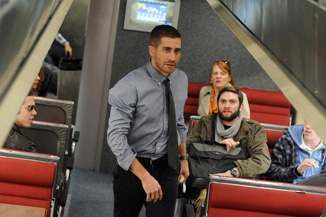|
|
Movie Review: Source CodeBy Matthew HuntleyApril 6, 2011
Because Source Code has a plot that hinges on tension and surprises, that’s where I stop. Based on what I’ve told you, the premise probably sounds absurd, but because it’s taken seriously and conveyed seamlessly by Ben Ripley’s screenplay and the actors, we’re fully onboard with it. Besides, after a while, the plot doesn’t seem to matter as much as the characters inhabiting it, which is impressive and unexpected for such a high-concept thriller. As Stevens’ caution and paranoia are replaced by his affection for the beautiful girl across from him, the movie turns from thriller to quasi romantic drama, and it works. The girl’s name is Christine and the more Stevens talks to her during every eight-minute session, the more he likes her. In a way, the thriller plot, which is effective in its own right, becomes secondary to the emotion being generated between these two people. There is a scene so powerful when Stevens and Christine, both lying down, are looking into each other’s eyes that it brings Source Code up to another level. At this point, we become fully invested. Most thrillers boil down to the last possible minute, with a quick denouement to quickly wrap up all the loose ends. Source Code resolves its plot faster but then goes extra distance with its characters, whose emotions are given more weight and screen time. The last third of the movie has a lot of patience and allows its characters to sit and talk, as when Stevens makes a heartfelt phone call or when Goodwin stares at another character, contemplating her integrity and morality. Such scenes really allow us to care about these people. The final scene will leave many viewers questioning what they just watched, but not in a frustrating way. We’re more in a state of awe and admiration, for the movie has earned our respect. The director is Duncan Jones, who last made Moon, a superior science fiction thriller. Like that movie, you want to see Source Code more than once for two reasons: 1) to make sure you got the plot right; 2) to let the characters enter your heart again. With most thrillers, it’s usually only the first reason that warrants a re-watch, but Source Code is different. It goes beyond the norm and lets its people become just as intriguing as its premise.
|

|
|
|

|
Thursday, October 31, 2024
© 2024 Box Office Prophets, a division of One Of Us, Inc.


